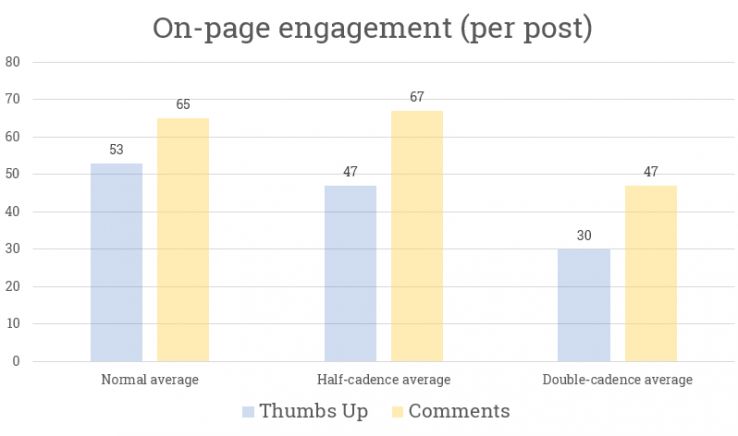Brands
How Often Should You Publish? Moz and HubSpot’s New Experiment Gives a Surprising Answer
“Quality, not quantity.”
It’s a maxim we hear all the time in publishing—one that has content strategists everywhere preaching that you don’t need more content, you just need better content.
That’s the assumption many content creators have been betting on.
Recently, two titans of content marketing, HubSpot and Moz, put it to the test. Both sites experimented with increasing and reducing their publishing cadence and tracked the consequences. And, in the timeless words of Upworthy, you won’t believe what happened next.
HubSpot: Is high volume the right play?
HubSpot runs one of the most prolific marketing blogs in the industry, publishing an average of 23 posts per workweek.
Over the course of six weeks, HubSpot ran three different editorial strategies in two-week phases to see how they performed.
- Their benchmark strategy: (23 posts per workweek)
- Low volume, high comprehensiveness: (11.5 posts per workweek)
- High volume, low comprehensiveness (34.5 posts per workweek)
HubSpot measured its success based on views, new leads, and subscribers—all organic. However, it only looked at traffic that comes from new posts published within that timeframe, since 92 percent of its leads and 75 percent of its traffic in a given month come from previously published posts.
Based on the adage that opens this article, the low-volume strategy should be most effective, right? Or at least just as effective as the rest. Not so.
HubSpot found that the low-volume phase received over 30 percent less traffic than the benchmark and high-volume phases.
That’s a pretty striking finding. But perhaps what’s most interesting is that the benchmark and high-volume phases received almost the same amount of traffic. In other words, consumers will pay roughly the same amount of attention to 23 posts as they will to 35. According to HubSpot, this points to a crucial conclusion: Its readers can only handle so much content.
Additionally, the lower-volume phase also saw a dip in traffic from email and social. The reason for this one is simple: The fewer posts that are published, the fewer links to click on in email and social. For HubSpot, the moral of the story here is: “Comprehensiveness can’t make up for frequency—at least when it comes to short-term traffic.”
The high-volume phase also garnered the largest number of leads among the phases—and almost double the leads of the benchmark phase.
However, HubSpot concluded, “considering new blog posts only account for 8% of our month’s lead generation capabilities, the difference in leads between these two phases is negligible.”
That’s not to say that HubSpot concluded that comprehensiveness isn’t a winning formula; as part of the experiment, HubSpot also analyzed the performance of the six types of posts it publishes, concluded that it would greatly benefit from increasing the number of “deep tactical posts,” its most comprehensive post type. For HubSpot, quantity is still king.
But the story doesn’t end there.
Moz: Do we even have to publish every day?
Moz ran the same experiment as HubSpot, but came to a significantly different conclusion.
Moz takes a substantially different approach to content marketing than HubSpot; it only publishes once per weekday, and all of its content tends to be extremely comprehensive.
Like HubSpot, Moz found that publishing at double its benchmark frequency resulted in increased traffic, and publishing at half its normal frequency resulted in decreased traffic—but with much smaller margins than HubSpot’s findings, with just a 2.9 percent drop in sessions.
Daily view:
Weekly view:
Moz also found that the experiment had minimal effect on its email subscriptions and the quality of its posts.
Additionally, engagement with Moz’s content (thumbs up and comments) remained rather steady during the half-cadence phase, in relation to the normal phase. However, engagement dropped when it increased the frequency of its posts. This finding fits HubSpot’s conclusion that readers can only take so much content before they stop paying attention or tune it out.
As a result, Moz concluded that the boost from doubling the cadence of its publishing was negligible—as was the dip during its half-cadence period. While it’ll stick to its strategy, it now no longer feels obligated to try and post every day.
The report states, “With some basic data clearly showing us that a day without a blog post isn’t the calamity we feared it may be, we’ve decided it’s time to raise the bar. When a post that’s scheduled to be published on our blog just isn’t quite where we think it ought to be, we’ll no longer rush it through the editing process simply because of an artificial deadline.”
It should be noted that both publications chose to largely stick with their current strategies, and yet both publications approach content production quite differently. Moz publishes less content at high quality, and HubSpot publishes more content of varying quality. So, what does that say about these experiments? Perhaps each publication’s audience grows accustomed to how frequently they consume this content, and large fluctuations in that frequency can throw them off.
It’s also clear that there is not one right way to publish across the board. Every publication needs to test its publishing frequency out for themselves to some extent to see how its readers respond. You don’t have to experiment as comprehensively as HubSpot and Moz did, but at least try out some top-line experimentation. For those looking to get started, HubSpot provides tips for running this test at the end of its report.
Image by Sergey NivensGet better at your job right now.
Read our monthly newsletter to master content marketing. It’s made for marketers, creators, and everyone in between.










